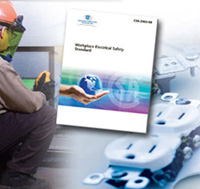Electrical Safety In The Workplace - Protecting Workers

Electrical safety in the workplace is a critical priority for employers, contractors, and facility owners in both the United States and Canada. The risks associated with energized electrical equipment—including electric shock, arc flash, and arc blast—pose serious hazards to workers across industrial, commercial, and institutional environments. National standards such as NFPA 70E in the U.S. and CSA Z462 in Canada provide a comprehensive framework for managing these dangers through safe work practices, training, and the proper use of protective equipment. As regulatory bodies and safety standards evolve, maintaining current knowledge and compliance is not only a legal requirement but also a moral and operational necessity.
Request a Free Training Quotation
Understanding the CSA Z462 and NFPA 70E Standards
CSA Z462: Electrical Workplace Safety is the foundational standard for managing electrical hazards on job sites in Canada. Initially introduced in 2006, CSA Z462 was developed in close alignment with the U.S. NFPA 70E Standard for Electrical Safety in the Workplace, ensuring a high degree of harmonization between Canadian and American practices. CSA Z462 is also coordinated with the Canadian Electrical Code and other Canadian standards like CSA Z460 (Control of Hazardous Energy—Lockout and Other Methods) and CSA M421 (Use of Electricity in Mines), reflecting a national approach to electrical safety across various sectors.
In the U.S., NFPA 70E outlines requirements for safe work practices to protect personnel from electrical hazards. It is widely used by employers to comply with Occupational Safety and Health Administration (OSHA) regulations under the General Duty Clause. OSHA recognizes NFPA 70E as a best-practice guide, though it is not itself a regulatory standard. Following Electrical Safety Procedures is always the best way to minimize workplace incidents.
Purpose and Scope of Electrical Workplace Safety Standards
The primary purpose of CSA Z462 and NFPA 70E is to guide employers and workers in identifying electrical hazards and implementing effective control strategies. These standards define key procedures such as:
Hazard and risk assessments
- Requirements for qualified versus unqualified electrical workers
- Selection of personal protective equipment (PPE)
- Arc flash and shock protection boundaries
- Electrical incident response planning
- Lockout/tagout procedures (LOTO)
CSA Z462, for example, includes specific annexes and informational sections to clarify best practices, such as simplified PPE category systems, the layering of flame-resistant clothing, and guidance on labeling for shock and arc flash hazards.
Who Is Responsible for Electrical Safety in the Workplace?
Electrical safety is a shared responsibility between employers, supervisors, and employees in the U.S. and Canada. Maintenance and engineering departments in industrial facilities often manage electrical systems, but upper management bears the legal and financial duty to provide a safe workplace. In commercial and institutional settings, building owners and operations managers are accountable for ensuring that qualified personnel conduct work in accordance with safety standards.
Employers are responsible for:
- Establishing an electrical safety program
- Providing appropriate electrical safety training for qualified and unqualified workers
- Ensuring PPE is available and properly maintained
- Conducting regular audits of safety procedures
- Utilizing Electrical Safety Products to enhance worker protection.
Supervisors enforce procedures, verify training, and ensure workers are not exposed to hazards unnecessarily. Workers must follow safe work practices and report unsafe conditions. In Canada, this responsibility is codified under provincial occupational health and safety legislation, while in the U.S., it is governed by OSHA 29 CFR Part 1910 Subpart S for general industry.
Recent Updates and Current Relevance
NFPA 70E and CSA Z462 both introduced new emphases on human performance and risk management. The most recent CSA Z462 also includes updates to:
- The arc flash PPE category table
- Definitions and terminology
- Electrical-specific hazard control programs
- Incident energy analysis methodologies
These changes reflect an industry-wide shift toward a more proactive and preventative safety culture.
Technical Foundations for Arc Flash Calculations and Signage
Tools and guidelines from organizations like the Institute of Electrical and Electronics Engineers (IEEE) and ANSI are commonly referenced to support the practical application of these standards. For instance, IEEE 1584-2018 calculates incident energy levels and determines arc flash boundaries. In addition, ANSI Z535 provides recommendations for hazard signage, ensuring workers are adequately informed about potential risks.
A Unified Commitment to Safety
Electrical safety in the workplace is not optional—it is a regulatory and ethical obligation. For organizations in the U.S. and Canada, staying aligned with NFPA 70E and CSA Z462 is essential to creating a safe, productive, and compliant work environment. Employers can significantly reduce the risks associated with electrical work by understanding responsibilities, staying up to date with evolving standards, and fostering a culture of awareness.
Whether in a manufacturing plant, a commercial building, or an institutional facility, electrical safety must remain a top priority—because every worker deserves to go home safe at the end of the day.
Arc Flash Group Training

We can present this Course to your electrical engineering and maintenance staff, on your premises, tailored to your specific equipment and requirements. We are ready to help design this program for you. Click on the link below to request a FREE quotation.
Live Online Electrical Training Schedule
October 2025
- Grounding and Bonding Training And The CE Code
- Arc Flash Training - CSA Z462 Electrical Safety
- Combined CSA Z462 LV & HV Electrical Safety Training
- High Voltage Safety Training
- NFPA 70e Training
- Substation Maintenance Training
November 2025
- Power Transformer Maintenance Training
- NFPA 70b Training - Electrical Maintenance
- Emergency Generators & Standby Power Systems
- 2024 CE Code - Combined Course: Changes/Fundamentals and Calculations
- 2024 CE Code - Changes and Fundamentals
- Lightning Protection Systems Training For Utility, Industrial, Commercial & Institutional power systems
